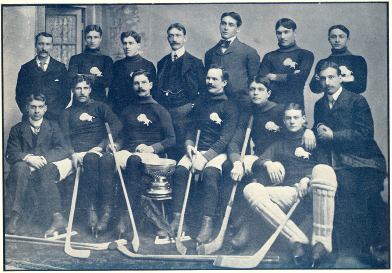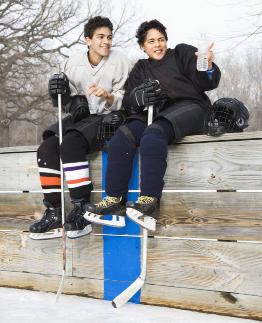Module 7
1. Module 7
1.1. Lesson 1
Module 7: Trigonometry
Lesson 1: The Tangent Ratio
Focus

Manitoba Sports Hall of Fame & Museum.
On January 31, 1901, the Winnipeg Victorias beat the Montréal Shamrocks in overtime in the second and deciding game for the Stanley Cup. This game marked the first time the Stanley Cup had been decided in overtime. Another first was the participation of Antoine (Tony) Gingras (standing second from the right), a Métis man from St. Boniface, Manitoba.
Gingras played right wing and was a top scorer on the team. He became the first French-speaking player on a Stanley-Cup-winning team. Many credit his success and popularity in Québec with the formation of the Montréal Canadiens, for whom Gingras later became a team scout.

© iofoto/shutterstock
Look at the photograph of two of today’s young hockey players. When you compare their gear to that of the Winnipeg Victorias, you can see how hockey equipment has changed over the years. Some of the change started with Gingras, who designed his own hockey stick. Gingras’ design became a basis for the modern version of the hockey stick.
The two hockey-playing boys each hold a modern-day stick with the shaft vertical and the tip of the blade touching the ice. The blade and the surface of the ice form an angle. By the end of this lesson you will be able to find what angle the blade makes with the ice surface.
Lesson Questions
In this lesson you will explore these questions:
What is the tangent ratio?
How is the tangent ratio used to find unknown sides and angles in right triangles?
Assessment
You will complete the Lesson 1 Assignment Booklet for assessment. Download the Lesson 1 Assignment Booklet and save it in your course folder now. You will receive instructions on how to complete the Assignment Booklet later in the lesson. You will also be prompted to start working on the Unit Assessment.
There are other activities that you will complete throughout this lesson. It is important to complete all activities and save them in your course folder. Your teacher may ask to see your work at any time.
The lesson provides you with opportunities to investigate, review examples, and practise the knowledge and skills you are learning. In Self-Check activities you can compare your answers to see if you are on track. If you are having difficulty with concepts or calculations, contact your teacher.
Required Materials and Equipment
You will need a piece of cardboard the size of a sheet of printer paper, a drinking straw, tape, scissors, a glue stick, a weight (such as a bolt or penny), thread, a protractor, a metric ruler, and your calculator.